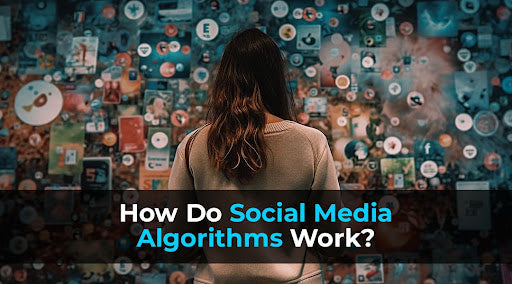
How Do Social Media Algorithms Work?
What is social media algorithm?
A social media algorithm is a set of rules that social media platforms use to decide what content you see in your feed. It's like a personal assistant that helps you find the content that's most relevant and interesting to you.
Imagine you're walking into a library with millions of books. You have no idea what you're looking for, so you ask the librarian for help. The librarian asks you a few questions about your interests, and then she picks out a few books that she thinks you might like.
Social media algorithms work similarly. They consider your past behavior on social media, such as the posts you've selected, shared, and commented on, to determine what kind of content you're interested in. Then, they use this information to personalize your feed by showing you content that they think you're most likely to like and engage with.
How does social media algorithm work?
Social media algorithms are like your digital butler, working hard behind the scenes to make sure your feed is full of stuff you love.
But if you want to understand the algorithm behind the working of social media, you are at the right place.
 How social media algorithm works?
How social media algorithm works?
Data Collection
Social media sites collect a great deal of personal data about you. This includes what you post, who your friends are, what you like, and even your location. They're like digital detectives collecting clues about your interests.
For example, if you often share cooking recipes, the platform learns that you're into cooking.
User Profile
Based on the data they've collected, the platform creates a profile for you. This profile includes details like your age, gender, hobbies, and who you follow. It's kind of like your online ID card. If you follow pages about travel and adventure, your profile will reflect your love for exploring new places.
Content Curation
The computer program looks at all the posts and content available, which are like the dishes at the buffet. It checks the kinds of posts you usually like or interact with. For example, if you often click the "like" button on posts about funny cat videos, it knows you love those.
Then, it picks the posts that it thinks you'll like the most, based on your past interactions and preferences. Those chosen posts are the ones you see on your social media feed. They're like the delicious dishes the chef put on your plate at the buffet because they match your taste.
Timeliness
Nobody likes stale news. The algorithm wants to keep your feed fresh, so it prioritizes recent posts over old ones. If there's breaking news about your favorite sports team, the algorithm will make sure you see it as soon as you open the app.
Source Matters
The algorithm also pays attention to where the content is coming from. It gives preference to posts from accounts you follow or engage with regularly. If you follow a famous chef and he posts a new recipe, then the algorithm will make sure it's at the top of your feed.
Machine Learning
Machine learning is like giving the social media algorithm the ability to learn from what you do on the platform. The more you use it, the better it becomes at understanding what you like and showing you more of that stuff.
For example, if you've been laughing at a comedian's jokes, the algorithm may suggest more content from that comedian or similar ones.
Feedback Loop
This is where your actions matter. When you like, comment, or share a post, it's a signal to the algorithm that you're interested in that type of content. It takes notes and will show you more of the same. If you comment on a friend's travel photo, the algorithm may show you more travel-related posts from other friends.
Ads
Social media platforms make money from advertisements. The algorithm also helps in this department. It looks at your profile and behavior to decide which ads you're likely to be interested in. If you often shop for sneakers online, you might start seeing ads for the latest sneaker releases.
How can you create content that performs well on social media algorithms?
Although social media algorithms are always changing, there are some broad guidelines you can go by when producing content to increase its chances of being shared and liked on any social media platform.
Create high-quality content that your audience finds interesting
This entails producing educational, captivating, and aesthetically pleasing information. Your content should also be relevant to the interests of your target audience. You can use social media analytics tools to learn more about your audience and the topics they are interested in.
Use relevant keywords and hashtags
Your content will be seen by readers who are interested in those topics more frequently if you include relevant hashtags and keywords in your posts. You can use keyword research tools to find popular keywords and hashtags in your niche.
Post consistently
The more often you post, the more opportunities you have to reach your audience. However, it's important to post high-quality content that your audience will find valuable. Don't just publish anything for the sake of posting.
Engage with your audience
Respond to comments, participate in conversations, and ask questions. Your audience will be more receptive to your content and you will have established relationships with them as a result.
Optimize your content for each platform
User behavior and algorithms vary amongst social media platforms. Make sure you use different formats and post at different times to optimize your content for each platform. For example, Instagram users tend to engage more with visual content, while Twitter users tend to prefer text-based content.
Utilize social media analytics to monitor your progress
Most social media platforms provide analytics tools so you can keep tabs on how well your content is performing. Use these tools to see what kind of content is resonating with your audience and what kind of content they are not as interested in. This information can help you improve your content strategy over time and grow your network effectively.
Here are some additional tips that may help your content perform better on social media algorithms:
- Use relevant social media features: For example, you can use Facebook Live to broadcast videos or Instagram Stories to share behind-the-scenes content.
- Run contests and giveaways: This is a great way to attract new followers and engage your existing audience.
- Promote your content on other channels: Share your social media content via email newsletters, your website, and other social media platforms.
- Use paid advertising. Promoting your content and reaching a larger audience can both be accomplished with paid advertising. However, it's important to target your ads carefully and track your results to ensure you are getting a good return on your investment.
Grow your social media network
In today’s digital world, the key to success lies in your ability to create content that not only resonates with your audience but also dances harmoniously with the algorithms. We've explored the essential ingredients to create a winning social media strategy, from understanding your audience and staying consistent to harnessing the power of eye-catching visuals and engaging with your followers.
Remember, social media is a dynamic and ever-changing landscape. What works today might not work tomorrow. Therefore, the most valuable skill you can develop is adaptability. Stay curious, keep learning, and be open to experimenting with new ideas and formats.
You might be working on more than one social media platform for your business. Sharing links of different social media platforms to your network at once can be a confusing and time-consuming task if you do it individually. TapOnn provides you with NFC-enabled smart business cards to share all your social media links with just a single tap.

Grow your network with TapOnn
As you embark on your social media journey, use these insights as your compass. And never forget, your uniqueness is your most potent asset. Let your authentic voice shine through your content, and watch as your engagement and influence continue to grow.



